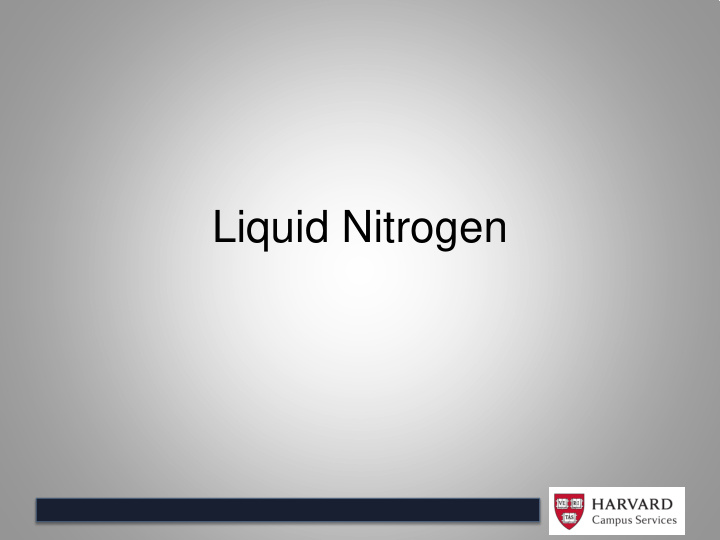



Liquid Nitrogen
Liquid Nitrogen-Physical Properties • Liquid nitrogen (LN2) is produced industrially by fractional distillation of air. Liquid nitrogen is a colorless clear liquid with density of 0.807 g/mL at its boiling point • At atmospheric pressure, liquid nitrogen boils at 77 K (−196 ° C; −321 °F) and can cause rapid freezing on contact with living tissue, which may lead to severe frostbite. When appropriately insulated from ambient temperatures, liquid nitrogen can be stored and transported in dewars and vacuum flasks. Here, the very low temperature is held constant at 77 K by slow boiling of the liquid, resulting in the evolution of nitrogen gas.
Hazards-Frostbite Liquid nitrogen can cause terrible "burns." The burns are caused by death of living tissue caused by the extreme cold, i.e., severe frostbite
Hazards-Oxygen Condensation? • Liquid nitrogen will condense oxygen from the air. This is most alarmingly demonstrated if a person leaves his/her vacuum pump's coldfinger in a dewar of liquid nitrogen overnight. In the morning the coldfinger will contain LIQUID OXYGEN up to the level of the nitrogen in the dewar
Hazards-Pressure Build-Up? • LN2 will rapidly boil off and pressure will build up. • Can lead to explosion of containers without venting devices • Can pressurize at an expansion ratio of 1:700
Hazards-Air displacement • Nitrogen is not poisonous; the air is already about 78% nitrogen (oxygen makes up about 21%, and trace gases the remaining 1%). • If sufficient liquid nitrogen is vaporized so as to reduce the oxygen percentage to below 19.5%, there is risk of oxygen deprivation. • Rapid venting (spills and releases) can cause near-total displacement of normal air, leading to a local concentration of about 100% nitrogen. Simple asphyxiants such as nitrogen do not have good warning properties!
LN2 Basics • Guard against pressure build-up by using a pressure relief vessel or a venting lid. • Always follow manufacturers' guidelines for use of cryogenic vessels of any size. • When transferring liquid nitrogen to containers, it is possible for intense splash and spraying, so ensure that appropriate shielding and engineering controls are in place. • Only use liquid nitrogen in well ventilated spaces!!!
Cryovial Basics •If at all possible, store cryovials in the vapor phase of liquid nitrogen freezers. Most manufacturers of cryovials do not recommend liquid-phase storage. •Do not over fill cryovials beyond the designated fill line. This will increase the risk of cracking and possible release of contents. •Use internally threaded caps, and do not over-tighten caps •For cryovials currently immersed in liquid-phase storage, it is recommended that tubes are placed in a sealed, unbreakable, plastic container immediately after removal from storage and prior to thawing. •Tubes can also be moved from the liquid-phase to the vapor- phase for at least 24 – 48 hours prior to removing from the storage container.
External vs Internal Threads
PPE and Engineering Controls • Cryogenic gloves, safety glasses and face shield • Long sleeved clothing, long pants, and closed toed shoes • Work in a well ventilated area. • Dewars must be secured in transport.
Shipping? • You must be DOT and IATA certified to ship LN2, as it is a dangerous goods. • Containers must be UN rated for transport LN2 • Use of a dry shipper allows many exemptions to shipping LN2
The End!
Recommend
More recommend